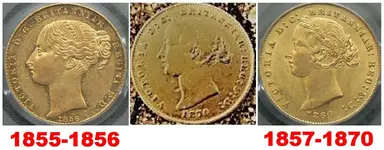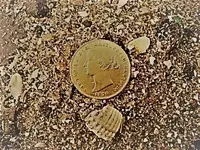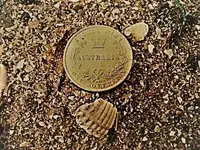Terrific find, and unusual for Britain. I wonder who brought it here.
It was a high-relief design, so it actually has a fair bit of wear.
I like buttery... buttery is good.
What is the year on it was it a war time era coin?
Looks like 1270, that can’t be correct
A little bit of coinage history:
After the discovery of gold in Ophir, New South Wales to the West of Sydney in 1851 and the start of the Australian gold rushes, there was lobbying from Australia for a branch of The Royal Mint to be established in Sydney to strike sovereigns. Permission was granted in August 1853 and the mint opened in May 1855. There were concerns in Britain about the refining expertise in Australia and the new mint’s ability to produce to the exacting standards demanded. The dies, master tools and other equipment were therefore sent from London together with supervisory personnel to train local employees and oversee the operation.
The first sovereigns were struck in 1855, specified to an identical weight and gold fineness standard as used in London, but were only legal tender in Australia. There was initial concern about the pale buttery yellow colour, but an assay in 1856 found that the coins minted in Sydney had 0.02% more gold in them than the coins of London, and that the colour difference was due to a higher amount of naturally-occurring silver in the alloy versus London production where the non-gold part of the alloy was almost exclusively copper.
As a further protection against the possibility of ‘inferior’ quality, the coins had an Australian-specific reverse design (crown in wreath with the words ‘Sydney Mint/Australia’), such that they could be more easily withdrawn from circulation in the event of any problems.
The dies had been prepared by James Wyon and, for the first two years (1855 and 1856), the obverse ‘young head’ portrait of Queen Victoria was adapted from the engraving his cousin William had produced for British coinage. James worked as William’s assistant until becoming Resident Engraver at the Royal Mint following William’s death in 1851. Then, in 1857, James produced a new obverse portrait with a distinctly ‘local’ element – a sprig of the wildflower banksia in the Queen’s hair arrangement, used until 1870 (with no mintage in 1859). So the found coin will be between 1857-1870 (looks like it might be 1870).

In 1862, it had already been decided that Sydney-minted coins should no longer have a unique Australian design but it took until January 1871 for a Royal Proclamation to authorise the use of the same designs as those used in Britain. From then onwards, the distinguishing feature was a small letter ‘S’ as a mint mark. Subsequent mints were established in Melbourne in June 1872, producing coins with an ‘M’ mint mark; and in Perth from June 1899, with a ‘P’ mint mark.









